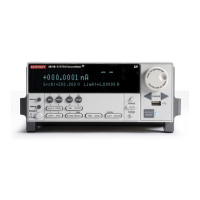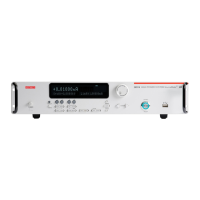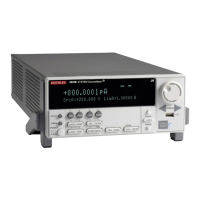12-58 Return to Section Topics 2600S-901-01 Rev. C / January 2008
Section 12: Instrument Control Library Series 2600 System SourceMeter® Instruments Reference Manual
Remarks • This function generates and activates new calibration constants for the given range. The
positive and negative polarities of the instrument must be calibrated separately. Use a
positive value for range to calibrate the positive polarity and a negative value for range
to
calibrate the negative polarity.
• Typically the two calibration points used will be near zero for calibration point 1 and 90%
of full scale for calibration point 2.
• All four measurements (cp1measured, cp1reference, cp2measured, and
cp2reference) must be made with the active calibration set. Corruption of the
calibration constants may result if this is not heeded.
• The new calibration constants will be activated immediately but they will not be
written to non-volatile storage. Use
smuX.cal.save to commit the new constants to
nonvolatile storage. The active calibration constants will stay in effect until the
instrument is power cycled or a calibration set is loaded from non-volatile storage
with the
smuX.cal.restore function.
• This function will be disabled until a successful call to smuX.cal.unlock is made.
Details See Section 16 "Calibration".
Also see smuX.cal.restore, smuX.cal.save, smuX.makebuffer, smuX.source.calibrateY
smuX.measure.count
X = SMU channel (a or b)
Attribute Number of measurements performed when a measurement is requested.
Usage count = smuX.measure.count -- Reads measure count.
smuX.measure.count = count -- Writes measure count.
count Number of measurements.
Remarks • This attribute controls the number of measurements taken any time a measurement is
requested. When using a reading buffer with a measure command, the count also
controls the number of readings to be stored.
• The reset function sets the measure count to 1.
Details See “Triggering” in Section 10.
Also see smuX.measure.overlappedY, smuX.measure.Y
Example Sets measure count for SMU A:
smua.measure.count = 10
smuX.measure.delay
X= SMU channel (a or b)
(Models 2635 and 2636 only)
Attribute Controls the measurement delay.
Usage
mdelay = smuX.measure.delay -- Read the measure delay.
smuX.measure.delay = mdelay -- Write the measure delay.
Set mdelay to one of the following values:
0 or smuX.DELAY_OFF No delay.
-1 or smux.DELAY_AUTO Automatic delay value.
user_value Set user delay value.
Remarks • This attribute allows for additional settling time before taking a measurement.
• The default is smuX.DELAY_AUTO.
• The smuX.DELAY_AUTO setting causes a current range-dependent delay to be inserted
when a current measurement function is called.
• If smuX.measure.count is greater than 1, the measurement delay is only inserted
before the first measurement.
• mdelay can be set to a specific user-defined value that sets the delay that is used
regardless of range.
• Use smuX.source.delay when measuring your source (source read back) and
smuX.measure.delay when stepping voltage and measuring current.
Also see smuX.measure.delayfactor, smuX.source.delay
Example smua.measure.delay = 0.010 Sets the measurement delay to 10mS.

